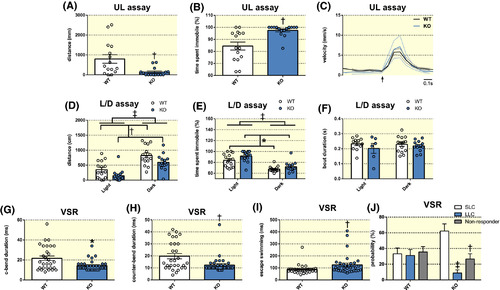
Effects of histamine receptor H3 (hrh3) deletion on larval behaviour. A, Total distance travelled, (B) time spent immobile and (C) average velocity during beat?glide swimming of larval hrh3?/? (KO) and corresponding wild?type (WT) fish in the larval unstimulated locomotion (UL) assay. The arrow in (C) indicates the onset of the swimming bout. n = 15/group. Mann?Whitney U test. ?P < .01 vs WT. D, Total distance travelled, (E) time spent immobile and (F) average swim bout duration in the larval light/dark transition (L/D) assay. n = 15/group. Two?way ANOVA. Significant main effects are indicated in the graph. ?P < .001, ?P < .01, *P < .05. G?I, Visual startle response (VSR) test. Larval KO fish displayed (G) shorter c?bend durations, (H) shorter counter?bend durations and (I) enhanced escape swimming compared to corresponding WT fish. n = 15/group. Mann?Whitney U test. ?P < .01, *P < .05 vs WT (J) In addition, KO fish were more likely to perform short latency c?bends (SLC) compared to long latency c?bends (LLC) and not responding at all. n = 15/group. Two?way ANOVA followed by Tukey's post?hoc test. ?P < .001, ?P < .01 vs SLC/KO. Data are presented as mean ± SEM
|

